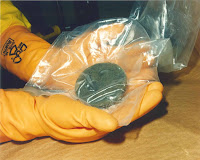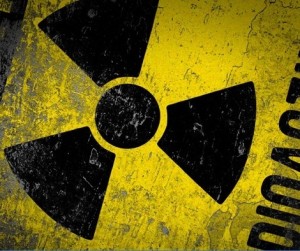 |
| This is how Plutonium looks |
And also gives us an understanding about how toxic this element Plutonium PU-242 with it's atomic number 94 is to humans and all living creatures on this planet.
The following is a letter found at https://www.ccnr.org/max_plute_aecb.html
(CCNR is a not-for-profit organization, federally incorporated in 1978. It is dedicated to education and research on all issues related to nuclear energy, whether civilian or military -- including non-nuclear alternatives -- especially those pertaining to Canada.)
How much plutonium does it take
to overdose a person?
Letter from the Atomic Energy Control Board
(followed by comments from CCNR)
re: Maximum Permissible Intake
of Plutonium by Inhalation
September 30 1999
Ms. Kristen Ostling
National Coordinator
Campaign for Nuclear Phaseout
1200-1 Nicholas Street
Ottawa Ontario
K1N 7B7
Subject:
Quantity of Plutonium that an Atomic Radiation Worker
and the Public may Inhale to Reach their Respective Limits
Dear Ms. Ostling:
The Atomic Energy Control Board (AECB) does not set maximum permissible
quantities of radionuclides for workers or the public. Regulatory
protection criteria are expressed in terms of effective dose limits.
In this context, we understand your question to mean: "What is the
quantity of plutonium oxide, if inhaled, would give rise to an effective
dose of 50 mSv [ millisieverts ] to a worker or 5 mSv to a member of
the public?"
As the result of an intake, these doses will be received over 50 years
by a worker and over a period ending at age 70 by a member of the
public. These calculations have been made for insoluble (in lung fluid)
plutonium oxide of 1 micrometer size. These assumptions are very
conservative (restrictive); in other words the worst case scenario has
been assumed.
workers:
1.4 micrograms for 50 mSv committed effective dose
(over 50 years after intake) public:
0.1 microgram for 5 mSv committed effective dose
(up to age 70)
If you have any other questions, please do not hesitate to contact me at (613) 996-5637.
Yours truly,
M. P. Measures, Ph.D.
Director
Radiation and Environmental Protection Division
Comments from CCNR
Foreword
Plutonium is a highly toxic material. Attempts to deny or to obscure this fact are, we feel, irresponsible.
Some spokespersons for AECL and for the Government of Canada have
suggested that there is no danger involved in MOX transport worthy of
anyone's serious consideration.
We feel compelled to point out that, although the probability of a
severe accident that would release plutonium to the atmosphere is
admittedly small, the potential health and environmental consequences of
such an accident can be serious due to the extraordinary toxicity of
plutonium when inhaled.
It is for this reason alone that the United States of America has made
it illegal to transport plutonium by air in US territory. Such a
prohibition does not exist for any other radioactive material.
Atomic Energy of Canada Limited has admitted, in documents submitted to
Transport Canada, that in four out of eight categories of serious road
transportation accidents, the MOX containers would be completely
destroyed and a plume of plutonium dust would be spread downwind to a
distance of about 80 kilometers.
Transport Canada has stated -- not once, but several times, in its
response to public commentaries about AECL's plans for MOX transport by
road -- that transporting MOX by air is much more dangerous than doing
it by road because of the health dangers of inhaling plutonium dust
following an accident.
Industry and government spokespersons have insisted that120 grams of
plutonium is too small an amount to raise legitimate health and
environmental concerns. They have made the irrelevant observation that
120 grams of plutonium is about the size of two A-A batteries.
Such remarks are manipulative in nature; they do not help people to
weigh the risk. The important quantity is not the VOLUME or MASS of
plutonium, but its TOXICITY. Based on data supplied by AECB (see letter
above) we can address the toxicity question as follows:
In principle, using AECB's regulatory limits,
how many ''civilians'' can be overdosed
by 100 grams of plutonium?
0.1 micrograms can overdose one civilian
multiply by one million
0.1 grams can overdose one million civilians
multiply by ten
1 gram can overdose ten million civilians
multiply by one hundred
100 grams can overdose one billion civilians 600 grams can overdose six billion civilians
If there is a serious accident involving
120 grams of plutonium (in the form of MOX),
how many civilian overdoses could, in principle, result?
if NONE of the plute
is safely contained
there is a potential for
one billion two hundred million
civilian overdoses
if 90 percent of it
is safely contained
there is a potential for
one hundred and twenty million
civilian overdoses
if 99.9 percent of it
is safely contained
there is a potential for
one hundred and twenty thousand
civilian overdoses
if 99.999 percent of it
is safely contained
there is a potential for
one thousand two hundred
civilian overdoses
In principle, using AECB's regulatory limits,
how many ''atomic radiation workers'' can be
overdosed by 140 grams of plutonium?
1.4 micrograms
can overdose
one atomic worker
1.4 grams
can overdose
one million workers
14 grams
can overdose
ten million workers
140 grams
can overdose
one hundred million workers
560 grams
can overdose
four hundred million workers
If there is a serious accident involving
600 grams of plutonium (in the form of MOX),
how many worker overdoses could, in principle, result?
if NONE of the plute
is safely contained
there is a potential for
four hundred twenty-five
million worker overdoses
if 90 percent of it
is safely contained
there is a potential for
forty-two and a half
million worker overdoses
if 99.9 percent of it
is safely contained
there is a potential for
forty-two and a half
thousand worker overdoses
if 99.999 percent of it
is safely contained
there is a potential for
four hundred and twenty-five
worker overdoses
If there is a serious accident involving
600 grams of plutonium (in the form of MOX),
how many civilian overdoses could, in principle, result?
if NONE of the plute
is safely contained
there is a potential for
six billion
civilian overdoses
if 90 percent of it
is safely contained
there is a potential for
six hundred million
civilian overdoses
if 99.9 percent of it
is safely contained
there is a potential for
six hundred thousand
civilian overdoses
if 99.999 percent of it
is safely contained
there is a potential for
six thousand
civilian overdoses
September 30 1999
| Subject: | Quantity of Plutonium that an Atomic Radiation Worker and the Public may Inhale to Reach their Respective Limits |
| workers: | 1.4 micrograms for 50 mSv committed effective dose (over 50 years after intake) |
| public: | 0.1 microgram for 5 mSv committed effective dose (up to age 70) |
Comments from CCNR
Foreword
Plutonium is a highly toxic material. Attempts to deny or to obscure this fact are, we feel, irresponsible.Some spokespersons for AECL and for the Government of Canada have suggested that there is no danger involved in MOX transport worthy of anyone's serious consideration.
Atomic Energy of Canada Limited has admitted, in documents submitted to Transport Canada, that in four out of eight categories of serious road transportation accidents, the MOX containers would be completely destroyed and a plume of plutonium dust would be spread downwind to a distance of about 80 kilometers.
Such remarks are manipulative in nature; they do not help people to weigh the risk. The important quantity is not the VOLUME or MASS of plutonium, but its TOXICITY. Based on data supplied by AECB (see letter above) we can address the toxicity question as follows:
is safely contained
civilian overdoses
is safely contained
civilian overdoses
is safely contained
civilian overdoses
is safely contained
civilian overdoses
is safely contained
million worker overdoses
is safely contained
million worker overdoses
is safely contained
thousand worker overdoses
is safely contained
worker overdoses
is safely contained
civilian overdoses
is safely contained
civilian overdoses
is safely contained
civilian overdoses
is safely contained
civilian overdoses
Afterword
The probability of a serious accident involving MOX transport is small, but the consequences can be severe. They can also be very long-lived: since plutonium-239 has a half-life of 24,000 years, plutonium contamination can be permanent. It is a betrayal of public trust to pretend that these risks do not exist.
Unlike most shipments of radioactive materials, plutonium shipments are attractive targets for criminals or terrorists, because plutonium is the primary nuclear explosive material from which atomic bombs can be made.
Any attempted hijacking can only increase the risks of unintended releases of plutonium to the atmosphere.








No comments:
Post a Comment